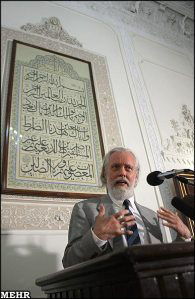
Islam and the Goal of Love
by William C. Chittick, The Huffington Post, November 6, 2010 08:20 PM
Muslim scholars who claimed that Islam specifically and religion generally are based on love were not simply talking through their hats, as many readers of my previous post seem to think. They offered plenty of evidence. In order to see its logic, however, we need to remember the two axioms upon which all Islamic thought is built: the reality of God and the messengerhood of Muhammad.
The first axiom does not depend on the Quran. It needs to be accepted before there is any reason to consider Muhammad and the message. If God is not real, then God’s “messages” will be even less real.
This first axiom states that there is only one true reality. Everything else — the universe and all it contains — derives from it. What we call “realities” are in fact non-realities dressed up in fancy clothes.
In the language of Islamic theology, this axiomatic notion is called tawhid (pronounced “toe-heed”), meaning “the assertion of unity,” that is, the unity of the ultimate reality, which is commonly called “God.” Any close reading of the Quran (and the works of practically any Muslim theologian, Sufi or philosopher) will show that tawhid is taken as self-evident to any healthy intelligence. If people miss it, the problem is “forgetfulness,” the outstanding characteristic of the human race. According to the Quran, Adam did not “sin”; rather, “He forgot” (20:115).
The second axiom of the Islamic worldview is that Muhammad is God’s messenger and the Quran God’s message. No matter how important this axiom may appear, it hangs on the axiom of God’s absolute unity.
Neither Muhammad nor the Quran is God. Both dwell in the realm of contingency and questions. Anyone who has delved into Islamic literature knows that every word of the Quran is open to interpretation. The very expressions used to designate the ultimate reality, God’s “most beautiful names” — such as Merciful, Knowing, Alive, Powerful, Forgiving, Majestic, Wise — need to be explained. Explanation and understanding are human attributes, which is to say that they are riddled with forgetfulness.
Literally, the word tawhid means to say one, to make one, to assert one, to declare one. Theologically it means to declare that the ultimate reality, by whatever name it may be called, is one. In this bald form, the statement is unremarkable, not least because it is found in practically all religious traditions and most pre-modern philosophy.
The grammatical form of the word tawhid shows that it is an assertion on the part of an asserter. The asserter is not the reality whose unity is asserted. Tawhid involves two, and that is precisely the problem. On our side, we have a constantly changing self, immersed in forgetfulness and barely aware of what it is saying. On the other side, we have an absolute and infinite Reality, fully conscious of all that exists.
Tawhid is a human act. Its purpose is to provide an orientation for understanding ourselves and the universe. It points to the dimensionless center of the circle of existence, or to the infinite, all-encompassing sphere — both symbolisms are commonly employed.
Once tawhid is accepted as the first axiom of thought, the goal of life becomes bridging the gap between the asserter and the asserted. In the language of Muslim piety, the goal is to achieve “nearness” (qurba) to God.
As created, contingent things, people dwell in dispersion, disarray, disharmony, dissonance and discord. Practically all human endeavor aims at escaping from these qualities. In the Quranic view, adequate paths of achieving integration, wholeness and unity have been provided by the prophets, beginning with the first, Adam. On the basis of divine instruction, they set down guidelines that can lead to conformity with the One Reality on the three levels of activity, thought and love.
As for love itself, as soon as Muslim scholars addressed its nature, they pointed out that it is essentially indefinable, as most everyone knows. Nonetheless, it has many symptoms and signs, the most basic of which is yearning for togetherness and desire for nearness. This is obvious in all its forms: romantic love, mother love, my love for my cats, your love for baseball, the soul’s love for God.
Love, in short, aims at communion, union, unity. Tawhid is the assertion of oneness and unity, but it is only an assertion, not the reality. Love is the energy that drives the quest for integration. The assertion of unity and the transforming energy must work together to overcome disjunction and disarray, to achieve togetherness and harmony, to actualize oneness and union. Tawhid provides the orientation, love the force. Without tawhid, love is dispersed and scattered; without love, tawhid is empty talk.
That the word “love” expresses the goal of tawhid is a common theme in the literature. Many explain it in terms of “the sentence that expresses unity” (kalimat al-tawhid). That is, the four Arabic words “(There is) no god but God,” the foundation of the Islamic creed.
Achieving the goal depends on overcoming the illusions set up by false realities, aberrant loves and misleading desires. In the language of Sufism, the false realities are called “others,” meaning everything that distracts the heart from the Absolutely Real. Rumi explains that love actualizes tawhid in these terms:
Love is that flame which, when it blazes up,
burns away everything except the Everlasting Beloved.It drives home the sword of “no god” in order to slay other than God.
Look closely–after “no god” what remains?There remains “but God,” the rest has gone.
Bravo, O great, idol-burning love!(Mathnawi, Book 5, verses 588-90)